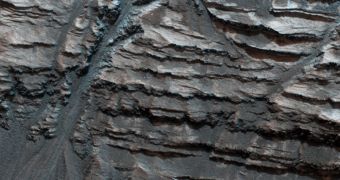Scientists operating the NASA Mars Reconnaissance Orbiter (MRO) have just released a new image of a landscape feature that may provide additional evidence to support the view that liquid water once flowed on the Red Planet.
The area of interest was imaged from orbit, experts say, and is located along the northern edge of the Hellas Planitia basin. Itself located in the southern hemisphere, this basin is a very interesting feature, as it contains a number of locations experts are very interested in.
The 170-kilometer (100-mile) Terby Crater is one of them. At one point, it was included on the list of potential landing sites for the Mars Science Laboratory (MSL) rover Curiosity. It has since been removed from that list, but experts still want to visit it in upcoming missions.
According to planetary scientists, the reason why this crater is so interesting is because its walls leave variable-toned layers of sedimentary rock exposed. Generally, this type of rocks are deposited in areas that are submerged under water for millions of years.
At the same time, MRO data reveal the presence of what looks like gullies flowing downward towards the crater floor. On Earth, such features are produced by water erosions, investigators explain.
At the base of the wall, the gully appears to have produced a fan-like material deposit. When viewed from above, this is similar to how rivers produce their deltas. Universe Today reports.
But finding structures such as this one does not necessarily imply that liquid water flowed on Mars in the planet's distant past. At least, not at every location where such carvings are found.
“While formation by liquid water is one of the proposed mechanisms for gully formation on Mars, there are others, such as gravity-driven mass-wasting (like a landslide) that don’t require the presence of liquid water,” explains scientist Nicole Baugh.
“This is still an open question that scientists are actively pursuing,” adds the expert, who is a targeting specialist for the High Resolution Imaging Science Experiment (HiRISE) instrument on the MRO.
One of the things supporting the hypothesis that water existed is the fact that the gullies are formed in sedimentary rocks that contain clay. The material is only formed in the presence of liquid water, geologists explain.
At other locations on Mars, experts are nearly sure that large volumes of flowing and standing water once existed in the open. The northern hemisphere may have even been home to a large ocean billions of years ago.
Experts believe that most of the water Mars had is now trapped in ice deposits at the two poles. These deposits can be found under a thin layer of sand, and were demonstrated to exist by the NASA Phoenix Mars Lander mission, Universe Today reports.

 14 DAY TRIAL //
14 DAY TRIAL //